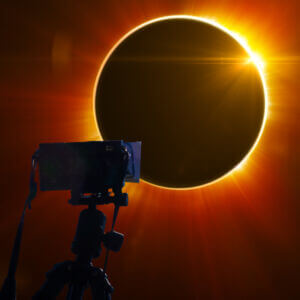
Eclipse Photography
Tips for Safely Photographing and Enjoying the Solar Eclipse
When setting up your photography equipment for the solar eclipse, it's crucial to prioritize safety and ensure that no one could accidentally look through an unfiltered camera lens at the Sun. If you find the technical aspects of filters, f-stops, and advanced photography challenging, consider leaving this task to professionals and focus on savoring the eclipse visually. Create lasting mental images that surpass photographs and stay with you for a lifetime.
If you still wish to capture photos:
- Avoid Using Flash: Never use any kind of flash during the eclipse, as it can ruin the dark adaptation of everyone's eyes and spoil the experience for onlookers.
- Use a Tripod: If possible, use a tripod for stability. If you don't own one, consider purchasing one to enhance the quality of your photos.
- Choose the Right Lens: Select a lens with a focal length of at least 300mm to ensure clear images. Phone cameras may require significant zooming, while standard point-and-shoot cameras may render the sun's image too small.
- Capture the Atmosphere: Take shots of the horizon and the crowd during totality to document the unique atmosphere.
- Video Recording: Set up a video camera pointed at the people around you (not the Sun) to capture the reactions during totality.
- Ensure Adequate Power: Change all your equipment's batteries 30 minutes before totality and charge them the night before.
- Protect Cameras from Heat: Cover your cameras with small white washcloths to prevent them from getting hot in direct sunlight. Additionally, wear a hat for personal sun protection.
- Use Solar Filters: Employ proper solar filters specifically designed for the purpose before and after totality. Remove them when totality begins.
- Pre-focus Cameras: Pre-focus all cameras on the full Moon two weeks before the eclipse and secure the settings with duct tape.
- Thorough Testing: Test all equipment beforehand until you are comfortable and familiar with the setup.
- Create a Checklist: Make a checklist of all necessary items and ensure everything is packed before leaving home.
- Learn from Others: Explore what others have done and try to create your own unique experience.
- Binoculars with Filters: Don't forget binoculars, as they are excellent for eclipse viewing. Use certified filters for them during the partial phases.
Remember to use solar filters when the eclipse is not total and refrain from using filters during totality. If you lack proper filters for your camera equipment, avoid attempting to take pictures to prevent damage.
For better pictures, invest in a long lens or telescope, connect your camera properly, use a stable tripod with a tiltable head, and employ a cable release for shutter control. Set the right exposure settings for different eclipse phenomena. Always use a certified solar filter when the Sun is not in total eclipse.
Whether you choose to photograph the eclipse or simply enjoy it visually, make the most of this incredible event within the limited time we have in the shadow. Eclipse Photography